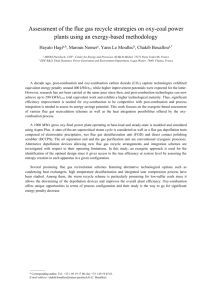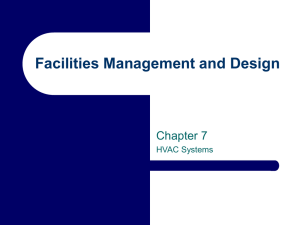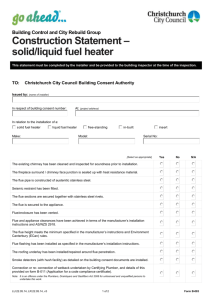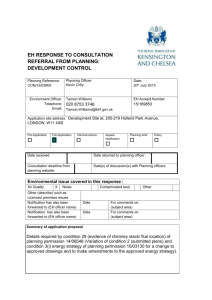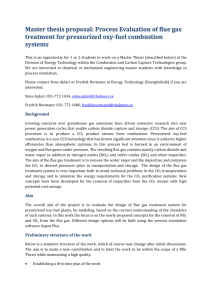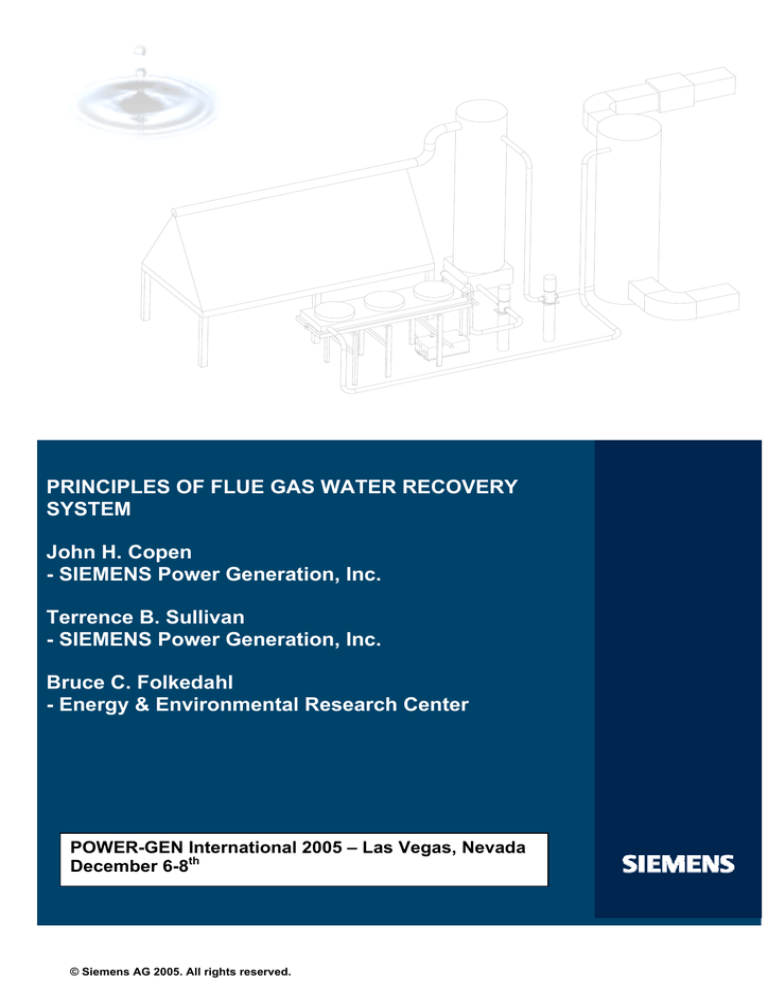
PRINCIPLES OF FLUE GAS WATER RECOVERY
SYSTEM
John H. Copen
- SIEMENS Power Generation, Inc.
Terrence B. Sullivan
- SIEMENS Power Generation, Inc.
Bruce C. Folkedahl
- Energy & Environmental Research Center
POWER-GEN International 2005 – Las Vegas, Nevada
December 6-8th
© Siemens AG 2005. All rights reserved.
ABSTRACT
This paper discusses a commercially viable and novel technology that enables the
recovery of the water vapor contained in power plant flue gas streams.
Currently, fossil fuel-based power plants consume vast quantities of water for heat
rejection, fuel preparation, power augmentation, emissions control, and cycle
makeup purposes. At the same time, global water resources are becoming more
difficult to procure as water consumption outstrips the pace of renewal. At present,
the strategy used to reduce power plant water consumption in areas where water
restrictions are stringent is to employ an air-cooled condenser as opposed to oncethrough cooling or a cooling tower. However, even plants with air-cooled condensers
to minimize water consumption require a significant amount of water in several cases
in order to allow for required steam drum blowdown, power augmentation systems,
and gas turbine inlet evaporative cooling or fogging systems in addition to the
aforementioned uses. To offset these observed escalating consumption rates, a new
system was devised that can recover a substantial portion of the water vapor present
in a flue gas stream. The water recovered by this system is of a quality similar to that
of a reverse osmosis system outlet (RO Out). This water can be used for various
plant needs as recovered or can receive minimal treatment so it can be used as
direct cycle makeup.
Siemens Power Generation, Inc. (SPG) and the Energy & Environmental Research
Center (EERC) at the University of North Dakota (UND) have successfully completed
the first phase of a U.S. Department of Energy (DOE) supported pilot-scale program
that verified the technical viability of this system. SPG, with the cooperation of the
EERC, is currently developing a commercial partnership with the goal of having a
1/10-scale slipstream commercial demonstration by the end of 2007.
This paper provides a detailed description of the pilot-scale system and process
conditions, presents the reportable results of the recent pilot-scale test program, and
discusses the expected commercial characteristics.
INTRODUCTION AND BACKGROUND
The electricity industry is second only to agriculture as the largest domestic user of
water, accounting for 39% of all freshwater withdrawals in the nation, of which 71%
is used in fossil fuel-based electricity generation. Power plants have to compete with
other industrial customers, agricultural interests, and households for this limited
commodity. The availability of water for use in electric power generation is limited in
many parts of the United States and is an important factor in obtaining site permits
for new plant construction. Difficulty or the inability to obtain necessary water permits
can lead to delayed or abandoned projects. Also, it is often the case that additional
infrastructure is required to provide a suitable supply, adding cost and environmental
impact. In areas that do not have an adequate water source, power plant
construction is not even considered, even though these locations are ideal in other
respects.
The goals of this flue gas water recovery project are to develop technology for
recovering water from combustion flue gases to reduce the net water requirements
1
© Siemens AG 2005. All rights reserved.
of power plants burning fossil fuels and to perform an engineering evaluation to
determine how such technology can be integrated into various power-generating
systems, including steam turbine and combined-cycle plants. Power plants burning
fossil fuels have in the past been designed to generate electricity at least cost under
circumstances of abundant coal and natural gas resources and adequate supplies of
water for plant cooling. Future plants will increasingly need to be designed and
operated to conserve both fuel and water. Water is becoming scarce and expensive
in many parts of the United States including California, where there is already a
strong economic incentive to reduce the net cooling water requirements of power
plant subsystems cooling steam turbine condensers and scrubbing stack gases.
Currently, coal-fired power plants require access to water sources outside the power
plant for several aspects of their operation in addition to steam cycle condensation
and process cooling needs. In integrated gasification combined-cycle (IGCC)
systems, significant water is used in the coal gasification process and for syngas
saturation, which is lost through the power plant stack. In pulverized coal (PC) power
plants, water inherent in the coal as well as water associated with flue gas scrubbing
is lost through the stack. Currently, the strategy used to reduce water consumption in
areas where water restrictions are stringent is to employ an air-cooled condenser as
opposed to once-through cooling or a cooling tower. However, even plants with aircooled condensers to minimize water consumption require a significant amount of
water in several cases in order to allow for required steam drum blowdown, power
augmentation systems, and gas turbine inlet evaporative cooling or fogging systems.
At the present time, there is no practical method of extracting the usually abundant
water found in the power plant stack gas. Some work has been done on using
mechanical heat rejection to condense water vapor. Such systems would require
massive and expensive heat rejection equipment, would be severely limited by high
ambient temperatures, and would result in decreased gas turbine performance as a
result of higher back pressure due to closed heat exchangers in the flow path. The
process being investigated in this project uses liquid desiccant-based
dehumidification technology to efficiently extract water from the power plant flue gas,
requires minimal heat rejection equipment, can function across the entire ambient
range, and results in only a small increase in exhaust pressure.
The advantage of using a liquid desiccant dehumidification system (LDDS) is to
facilitate the recovery of useful amounts of water at flue gas temperatures that can
be reasonably achieved during power plant operation. Direct contact cooling with a
desiccant solution can be engineered to minimize pressure drop, and any water
evaporating into the flue gas from an upstream scrubber would be recovered for
reuse. The alternative of indirect cooling in an air/flue gas-condensing heat
exchanger without a desiccant, which would be limited to applications involving low
ambient temperatures, raises significant engineering and economic problems
involved with the size and cost of the heat exchange equipment, exhaust pressure
drop, corrosion, fouling, and discharge of non-buoyant stack gas.
This project is a two year program to demonstrate the feasibility and merits of a liquid
desiccant-based process that will efficiently and economically remove water vapor
from the flue gas of coal-fired power plants (IGCC and PC steam plants) to be
recycled for in-plant use or exported for clean water conservation. Reduction of
water consumption by power plants is quickly becoming a significant issue when
2
© Siemens AG 2005. All rights reserved.
attempting to obtain permits for power plants and when required to meet new, more
restrictive water consumption allowances currently being considered by the U.S.
Environmental Protection Agency (EPA) under proposed Rule 316b.
EXPERIMENTAL
The program is divided into ten tasks as follows:
•
•
•
•
•
•
•
•
•
•
Task 1 – Desiccant Selection
Task 2 – Desiccant Laboratory Test Evaluation
Task 3 – Test Plan Development
Task 4 – Test Facility and Equipment Design
Task 5 – Equipment and Materials Procurement
Task 6 – Test Equipment Installation
Task 7 – Testing
Task 8 – Test Data Evaluation
Task 9 – Commercial Power Plant Evaluation
Task 10 – Program Management
The initial portion of the project involved an investigation of the potential viability of
various desiccants to meet program requirement. The selection of a desiccant for
the proposed system was predicated on several criteria. These criteria were
identified, applicable chemical/physical/environmental/cost data were gathered, and
the data compared. A weighted ranking system based on a criteria list was
developed for use in the evaluation and comparison of the candidate desiccants.
From the numerous desiccants considered, three candidate desiccants were chosen
for a bench-scale test as part of Task 2. Based in part on the results of this benchscale testing, a final desiccant was selected to be used in the larger pilot-scale Water
Extraction from Turbine Exhaust (WETEX) demonstration using the EERC’s slagging
furnace system (SFS) as a flue gas source. This combustion test furnace is
described in detail under separate documentation1. Two 1-week tests were
performed under Task 7 in the pilot-scale testing of the WETEX process. The first
test used natural gas as the combustion fuel, and combustion and exhaust
conditions were set to simulate a natural gas-fired combined cycle plant having a
moisture level in the flue gas of nominally 7% by volume. In Test Two of the pilotscale testing, a Powder River Basin (PRB) coal was used as the combustion fuel,
and combustion conditions were set to simulate a PC-fired power generation plant
with a wet scrubber having a moisture level in the flue gas of nominally 14% by
volume. To provide the required moisture level in the flue gas entering the WETEX
process system during the coal-fired test, additional water was injected into the flue
gas stream. In both tests, the flue gas exhaust from the furnace was fed to the
WETEX process system, which is illustrated in Figure 1 as a schematic of the
general testing process layout.
3
© Siemens AG 2005. All rights reserved.
Figure 1. Schematic of the General Testing Process Layout
4
© Siemens AG 2005. All rights reserved.
The absorber tower illustrated in the schematic (Figure 1) shows the location of the
six spray levels that were used to inject the liquid desiccant in a countercurrent flow
to contact the flue gas. In the test procedure, the number of spray levels used was
varied to aid in determining effective liquid to gas (L/G) ratios. In addition, spray
nozzles of different sizes producing different flow rates, spray patterns, and droplet
sizes were also interchanged during the testing. While the majority of the testing
consisted of a spray tower configuration, tests were also performed in a packed bed
configuration which used one spray level just above a 3 foot bed of polypropylene
saddle type packing. The packing was supported on a grate just above the flue gas
inlet to the absorber tower. Flue gas flow through the tower was kept constant at 450
acfm to achieve a velocity of 10ft/s through the tower. There was a high-efficiency
mist eliminator positioned at the top of the spray tower to control any entrained
desiccant. The mist eliminator had water wash nozzles above and below it for online
cleaning. The spray tower and the flash drum were constructed of 316 SS but the
desiccant piping to the absorber and to and from the flash drum were chlorinated
polyvinyl chloride (CPVC) Schedule 80.
As stated, the flash drum was constructed of 316 SS and was operated at subatmospheric conditions to facilitate the evaporation or flashing of water from the
desiccant solution. Weak desiccant solution (desiccant that has passed through the
spray tower and has absorbed water diluting the desiccant concentration in solution)
was introduced into the flash drum through a nozzle that sprayed the desiccant
solution to flash the water off as a vapor. The water vapor was removed by creating
a vacuum at the exit of the flash drum. This vacuum was maintained by a heat
exchanger cooled by water that condenses the vapor to liquid. This condensed
water was then collected as the produced water from the process. The strong
desiccant solution was collected by passing through a barometric leg which imparted
a liquid seal for the sub-atmospheric conditions in the flash drum and allowed the
collection tank to be open to the atmosphere. Desiccant flow rates and temperatures
were varied to the flash drum to aid in determining the effectiveness at different
process conditions.
Two separate tanks were used in this process for desiccant collection. One tank was
located at the base of the spray tower and collected the weak desiccant solution and
the other tank was located at the base of the flash drum barometric leg and was
used to collect the strong desiccant solution. The tanks were fabricated from
copolymer polypropylene so as to withstand the corrosive nature of the desiccant
solution. Both of the tanks were located within a secondary steel containment vessel
as a precautionary measure against leaks and material failures. The tank at the base
of the flash drum had a 100-gallon capacity, and the tank at the base of the absorber
had a 500-gallon capacity. Tank levels were monitored by differential pressure
transmitters. Piping between the tanks and the absorber and the flash drum was
configured such that the desiccant solution could bypass the flash drum and
absorber to allow for maintenance without necessitating a shut down of the entire
process. A filtration system was connected to the larger 500-gallon tank which was
used to filter out any particulate contaminants or precipitates that form in the
desiccant solution during operation or when loading desiccant into the system. The
filter bags used in this test had size ratings of 5, 10, and 25 microns.
5
© Siemens AG 2005. All rights reserved.
The system was designed with three heat exchangers with the following purposes:
• One to cool the strong desiccant prior to introduction into the absorber tower
• One to heat the weak desiccant prior to introduction into the flash drum
and
• One to condense the water vapor coming from the flash drum.
All of the heat exchangers were of a shell-and-tube design. The heat-transfer fluid for
the cooling heat exchanger and the condenser was water while the heat-transfer
fluid for the heat exchanger for heating of the desiccant was steam. The commercial
process condenser theoretically should provide the vacuum necessary to flash the
water from the weak desiccant solution. However, for this pilot-scale testing, a liquid
ring pump was added downstream of the condenser to assist in maintaining the subatmospheric conditions in the flash drum and to remove any non-condensable gases
from the flash drum and condenser.
During the test periods, O2, SO2, NOx, CO, CO2, and H2O in the flue gas were
continuously recorded. In addition, several EPA Method 5 sampling procedures were
used to measure H2O, particulate mass loading, and other species in the gas
stream. Desiccant solution samples were collected and analyzed for specific gravity,
pH, sulfates, and total suspended solids. Produced water samples were analyzed for
pH, conductivity, alkalinity, total hardness, calcium, magnesium, iron, copper, zinc,
sodium, potassium, chloride, sulfate, nitrate, orthophosphate, and silica.
PILOT-SCALE TEST RESULTS AND DISCUSSION
Several process conditions were tested during the pilot-scale testing. Flow rates,
number of spray levels, desiccant temperatures, and process configurations were
varied. In general, the system operated as expected or better than expected through
all of the process conditions.
When firing natural gas to produce the flue gas for the WETEX system, sulfur in the
gas was relatively low and not an issue with respect to an interaction with the
desiccant or produced water. When firing coal, the sulfur levels were higher and
needed consideration. When firing natural gas the flue gas SO2 values were
nominally 15 ppmv, and during the coal tests the SO2 values in the flue gas
averaged 230 ppmv. The level of sulfur in the coal-fired tests caused the pH of the
desiccant solution to become rather low and subsequently required a system
modification that increased the pH of the desiccant solution during the testing. It is
not expected that the sulfur removal from the flue gas will be detrimental to the
overall operation of the process, but in contrast, has the potential to be utilized as a
polishing step to further reduce levels of sulfur emissions during coal combustion.
During the combustion testing, no attempts were made to control the NOx levels,
which varied from 27 to 43 ppmv during the natural gas tests and 182 to 641 ppmv
during the coal-fired test. The presence of NOx at these levels appeared to have little
effect or interaction with the desiccant solution. Analysis of the off-gas vapor stream
of the product water condenser indicated that CO2, CO, and SO2 were not present.
Average O2 values of approximately 18% by volume and NOx levels of nominally 110
ppmv were recorded. Because of the sub-atmospheric pressure in this portion of the
system, it is probable that this stream is dominated by air in-leakage, and the NOx
6
© Siemens AG 2005. All rights reserved.
levels indicate a very small amount of flue gas dissolved in the solution and released
in the flash drum.
Water removal from the flue gas ranged from 23% to 63% by volume, with the
process conditions dictating the percentage of moisture removed. Higher
percentages of moisture removal required higher energy inputs for heating and
cooling. However, process conditions that required little or no external heating or
cooling still removed a significant volume of water from the flue gas. Figure 2
illustrates the amount of moisture available in flue gas from different types of power
plants firing different fuels. In the case of the 2X1 F Class natural gas fired gas
turbine cycle, if the plant were to be configured with an air-cooled condenser (ACC)
for low pressure steam turbine exhaust steam condensing, water usage for the plant
would be approximately 250 gallons per minute (gpm), inclusive of all plant needs.
When evaluated against the nominally available 375 gpm per turbine, or an available
nominal total of 750 gpm for a 2X1 plant, using a WETEX system sized to remove
approximately 33% of the available moisture would provide for all of a plant’s water
needs. This can be achieved without the need for any external heating or cooling
introduced into the system, making this a very economical system from an operating
cost standpoint.
Figure 2. Typical Flue Gas Water Content
The quality of the water produced using the pilot-scale system is exceptional. Figure
3 illustrates the quality of the water produced during the pilot-scale testing as
compared to water produced in a RO system that is used to purify water in a boiler
water makeup system in a power plant. With the exception of a slightly higher level
of calcium as CaCO3 value, the produced water from the LDDS in Test Series I is
equal to or better than that of the water from RO in a typical power plant. Water from
RO is generally near boiler makeup water-ready, with potentially a degasing step
prior to introduction into the steam cycle.
7
© Siemens AG 2005. All rights reserved.
Figure 3. Pilot-Scale Product Water Quality Compared to RO Outlet Water
CONCLUSION
Data and results that were collected through the testing phases of this program have
provided the initial values of a commercial power plant evaluation (Task 9). Though
final material selection for a commercial application has not been determined,
several candidate materials have been identified for consideration, ranging from
corrosion resistant alloys through readily available polymers and plastics. Further
planned testing by SPG and the EERC is at present in progress with specific
milestones established for collection of long term operability data and the
subsequent finalized design of a 1/10 scale commercial demonstration unit. SPG,
with the cooperation of the EERC, is also at present developing relationships with
industrial partners that are interested in the continued development of this
technology through supply of engineering services or the provision of a host
demonstration site.
The current conceptual commercial application for this technology can be arranged
in a slip stream configuration, external to the flue gas path, or in a full flow
configuration, placed directly in the flue gas path. In a natural gas fired combined
cycle, this system would interface just after the last heating surface of the HRSG. In
a coal-fired plant, this system would interface downstream of a wet flue gas
desulfurization (FGD) system, where it could remove the majority of the moisture
introduced by the FGD process. Figures 4, 5 and 6, show the process arrangement
and the conceptual layout of a commercial slip stream WETEX system.
8
© Siemens AG 2005. All rights reserved.
Figure 4. WETEX Commercial Process Arrangement
Figure 5. WETEX Conceptual Commercial Layout - Isometric
A – Flue Gas Inlet
B – Flue Gas Exit
C – Absorber Tower
D – Regenerator
E – Air Cooler Condenser
F – Desiccant Cooler
G – Pumps
B
D
C
E
G
A
F
9
© Siemens AG 2005. All rights reserved.
Figure 6. WETEX Conceptual Commercial Layout – Plan
Strong Desiccant
Weak
Desiccant
An economic evaluation for a commercial system was also conducted. The study
results indicate that given the current increasing usage trends seen in power plant
dry cooling technologies (Figure 7), as well as the observed increase in water rights
legislation and water usage permitting difficulties, systems designed to recover the
water contained in combustion flue gas streams will steadily become more
commercially viable.
Figure 7. Dry Cooled Power Plant Orders Vs Time
200
Nu m b er of New P lants
180
160
Number of New
Plants Built with
Dry Cooling
140
120
93
100
80
68
60
33
40
20
11
18
0
1980-1984 1985-1989 1990-1994 1995-1999 2000-2004 2004-2009 2010-2014
Although current economic models indicate that a net positive return on initial
investment is achievable when employing this technology, it will take several years of
development and continued focus on water resource management before systems
such as this yield the level of return that will warrant their common use.
10
© Siemens AG 2005. All rights reserved.
REFERENCES
1. Hurley, J.P.; Weber, G.F.; Henderson, A.K.; Hajicek, D.R.; Kleven, P.L.; Collings,
M.E. Engineering Development of Coal-Fired High-Performance Power Systems
– Phase II ; Final Report for United Technologies Research Center Contract No.
DE-AC22-95PC95144; Energy & Environmental Research Center: Grand Forks,
ND, Feb 2001.
11
© Siemens AG 2005. All rights reserved.


